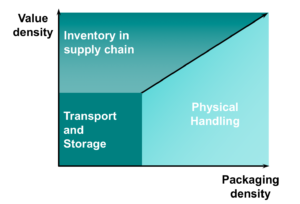The well‐known motto ‘different products, different requirements’ is, of course, derived from practical experience. This is also true for last mile configurations. From a cost perspective, two product characteristics are relevant: value density and packaging density.
Value density is the value per cubic meter.
Packaging density is the number of items handled per cubic meter.
Value density
The value density is the value of one cubic meter of product. For choosing a mode of transport (and the speed in the supply chain), it makes a huge difference whether one cubic meter with a value of 500 Euro (like groceries) or one cubic meter with a value of 500,000 Euro (like pharmaceuticals) has to be transported.
For products with a low value density, an inexpensive and therefore relatively slow mode of transport should be chosen. With these products, the costs of transport are an important part of the fulfilment cost. The same is true for storage cost, that is also related to cubic meters stored; less is more.
For products with a high value density fast and reliable supply chains are required. Here, the cost of working capital will be more important than the cost of transport, storage or handling. The value density will also be an important factor if a decision has to be made about whether or not to hold stock centrally.
Products with a high value density should be held in stock upstream in the supply chain (fast delivery and cross-docking will support responding to consumer demands). The use of advanced sales and operations planning tools to sense and respond is essential; ‘clockspeed’ is crucial.
Smart product design could help increase value density (which will result in lower cost transport); too much air is handled in e-fulfillment.
Packaging density
Packaging density is the number of items actually handled per cubic meter. Here is often referred to the ‘standard box’ or ‘outer box’. But, you have to take a closer look in the supply chain.
A full pallet of a product, for example from Unilever to the distribution center of retailer Jumbo, is regarded by Unilever as one handling unit. Then the packing density is low; the full pallet is handled once from the pallet location to the truck.
But at the Jumbo distribution center, the full pallet is stored and the products are loaded per box in a roll container that goes to the stores. Then the packing density is higher; about 30 packages in a cubic meter. If Jumbo delivers to consumers at home, there are even 800 different products in a cubic meter. The packaging density, therefore, often increases as we move downstream in the supply chain towards the last mile.
The higher the packaging density, the more important the handling cost will be. The cost of transport, storage, and working capital are of lesser importance. The proper last mile configuration should focus on fewer large distribution centers, economies-of-scale, lean processes, warehouse robotization and automation, and advanced warehouse management systems. Another strategy could be reducing packaging density by e.g. designing food boxes that are prepicked, pre-picked and packed products or e-commerce ready packaging.
Wehkamp
Different product, different requirements. Dutch pure player Wehkamp has a separate supply chain set-up for white goods and furniture focused on low cost of last mile transport from a conventional warehouse in the center of the Netherlands (low value density, low packaging density) versus fashion products and consumer electronics focused on efficiency in a highly automated warehousing in Zwolle (high value density, high packaging density). Cross-docking is done for products with a high value density by many omni channel retailers.
For more information, check out this paper from 1986: Ploos van Amstel, M. J. (1986). Physical distribution and product characteristics. International Journal of Physical Distribution & Materials Management, 16(1), 14-36.
For other characteristics, check out: Lovell, A., Saw, R., & Stimson, J. (2005). Product value‐density: managing diversity through supply chain segmentation. The International Journal of Logistics Management.

